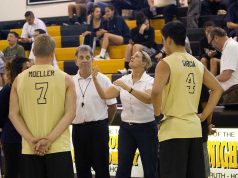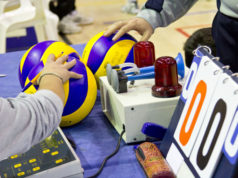We have all had matches that move along just fine — ballhandling on point, bench management under control, good tempo to the match … and then it happens. It is a play that can make or break your credibility. It is a play that can put your partner in an awkward position. It is a play that can take a calm coach and turn him or her into being infuriated in milliseconds.
The play I speak of? A back-row setter attempting to save a ball that is near, or maybe in, the plane of the net.
You are going to have one of four outcomes: illegal back-row attack, illegal back-row block, prolonged contact or play on. These plays can be very difficult for a variety of reasons but plays happening at the net and on top of the net are the ones we really need to get right. These are the decisions that need to be made quickly and decisively … the ones that put our skill on display and in general, put coaches’ minds at ease. Of course, we know that at certain times we will be getting an earful from one side or the other depending on who we whistle for the fault.
In many cases you may be told, “Expect the unexpected.” However, I would like to make a slight edit to that saying: “Expect the expected and be prepared for the unexpected.” This mantra may help us more when these plays occur during a match. Let’s look at two situations, possible outcomes and factors that may affect our decision.
Situation 1:
The ball is above the height of the net and it is clearly on the attacker’s side of the net. The back-row setter is in the action of setting the ball to a teammate. The attacker puts the ball over the net and an opposing player makes a play on the ball. Play continues. This is the expected.
The ball is above the height of the net and it is clearly on the attacker’s side of the net. The back-row setter sets the ball to one of her teammates. The attacker swings and gets a kill. Point awarded to the attacking team. This is the expected.
The ball is above the height of the net and it is clearly on the attacker’s side of the net. The back-row setter attempts to set the ball to a teammate. The ball drifts into the plane of the net and a blocker touches it before her attacking teammate . Point awarded to the blocking team and back-row attack is whistled. This is a possibility — be ready!
Questions to ask:
Was the ball clearly above the height of the net to make this a back-row attack? Did the ball enter, or completely cross, the plane of the net? Did the blocker touch the ball before the attacker? If the ball did not reach the plane of the net, and the blocker touched it, was there a player on the attacking team nearby and making an attempt to play the ball?
The ball is above the height of the net and it is clearly on the attacker’s side of the net. The back-row setter is in the action of setting the ball to a teammate. A blocker reaches over and blocks the ball as, or after, it is set. Point awarded to the attacking team and reaching over the net is whistled. This is the unexpected — why would she do that?
Questions to ask:
Was the ball clearly on the setter’s side of the net to make reaching over the correct call? Was the setter directing the ball to a teammate or toward the opponent’s side of the court? Did the blocker definitely make contact with the ball? Was the blocker’s contact a block or an attack?
Referee reflection time:
Did you see the contact by the blocker? How did you and your partner communicate? Did you shift your focus to the attacker too quickly? Was your whistle weak because you had no air, as you didn’t expect the blocker to reach beyond the net? Did you appear confident in your decision?
Situation 2:
The ball is passed and enters the plane of the net. As the back-row setter sets the ball to a teammate, there are no blockers making an attempt to block the ball. The attacker hits the ball into the opponent’s court where it is kept alive by the opposing team. Play continues. This is the expected.
The ball is passed and enters the plane of the net. As the back-row setter sets the ball to a teammate, there are no blockers making an attempt to block the ball. The attacker hits the ball to the floor of the opponent’s court. Point awarded to the attacking team. This is the expected.
The ball is passed and enters the plane of the net. As the back-row setter is contacting the ball, a blocker simultaneously makes contact with the ball. Point awarded to the blocking team and back-row block is whistled. This is a possibility — be ready!
Questions to ask:
Had the ball definitely broken the plane of the net? Who actually made first contact with the ball? Was the setter definitely reaching higher than the top of the net when contact was made with the ball?
The ball is passed and enters the plane of the net. The setter contacts the ball first, followed by a contact by the blocker. Point awarded to the blocking team and back-row attack is whistled. This is a possibility — be ready!
Questions to ask:
Had the ball definitely broken the plane of the net? Who actually made first contact with the ball? Was the ball completely above the height of the net when the setter made contact with the ball?
The ball is passed and enters the plane of the net. As the back-row setter contacts the ball and blockers are attempting to block, the contact is not made cleanly (whether it be under- or over-controlled). Point awarded to the blocking team and a double contact or caught/thrown ball is whistled. This is the unexpected — her hands have been so good all night!
Questions to ask:
Did the blockers contact the ball before, during or after the set? Who made the next contact — the attacker or a blocker? Where was the ball when it was contacted next? Did the setter make a double contact? Did the setter have prolonged contact with the ball, leading to a caught/ thrown fault?
Referee reflection time:
Did you observe that no blockers touched the ball? How did you and your partner communicate? Were you over-focused on whistling back-row attack or back-row block? Did you have a late whistle, but made the correct ballhandling call? Did you miss the call because you were not focused in the correct spot (on the setter’s hands)?
These situations do not cover every possibility, but give an overview of two common occurrences with possible outcomes. When net play is about to happen, or is happening, where are you focused? How do you prepare for what’s about to happen (or not)? How do you communicate with your partner during tight plays at and above the net? How accurate are you with your decisions in these situations?
As match facilitators, there is one non-negotiable … we must have knowledge of the rules! For example, if a back-row attack is whistled, it is because certain criteria are met: 1) a back-row player played the ball within the front zone; 2) the ball was completely above the height of the net; and 3) the ball completely crossed the net or was legally blocked by the opponent.
Knowledge of the rules applies to both situations and all possible outcomes listed. On top of that, we must be able to communicate clearly and succinctly why we whistled a fault or not. Therefore, it is vital to read the rulebook, reflect on your performance with trusted peers, observe high-level referees work matches, and improve how and what we communicate to captains and coaches. Additionally, stay active and get as much court time as possible in order to gain experiences to better deal with similar future situations. We may not succeed the first time, but there is no excuse for not improving the next time(s) it occurs!
Here is a takeaway. There are four Rs that can help us improve in our performance and get these calls correct more often:
Read — rules knowledge from reading the rulebook.
Repetition — the more matches you do, the more you will see these types of plays.
Reflection — be honest in your self-assessment and talk to other referees.
Readiness — be prepared, be confident, be focused in the right spot at the right time.
Bill Thornburgh, Simpsonville, Ky., is a National USAV and PAVO referee, as well as a FIVB International referee. He works in the Big Ten, ACC, SEC and other D-I conferences in the Midwest. *
What's Your Call? Leave a Comment:
Note: This article is archival in nature. Rules, interpretations, mechanics, philosophies and other information may or may not be correct for the current year.
This article is the copyright of ©Referee Enterprises, Inc., and may not be republished in whole or in part online, in print or in any capacity without expressed written permission from Referee. The article is made available for educational use by individuals.



















